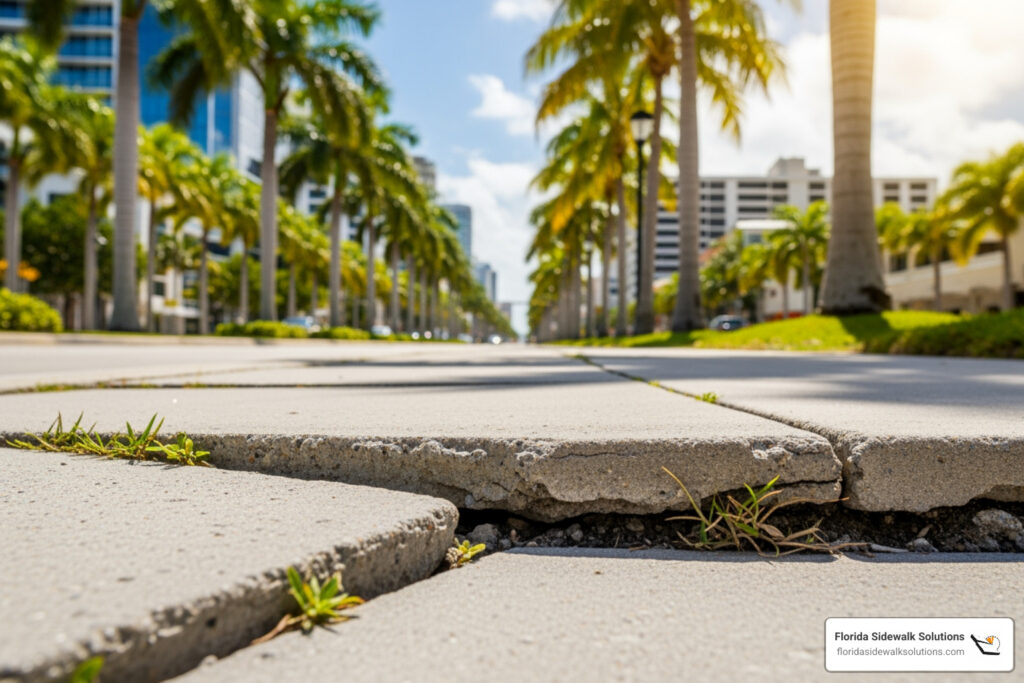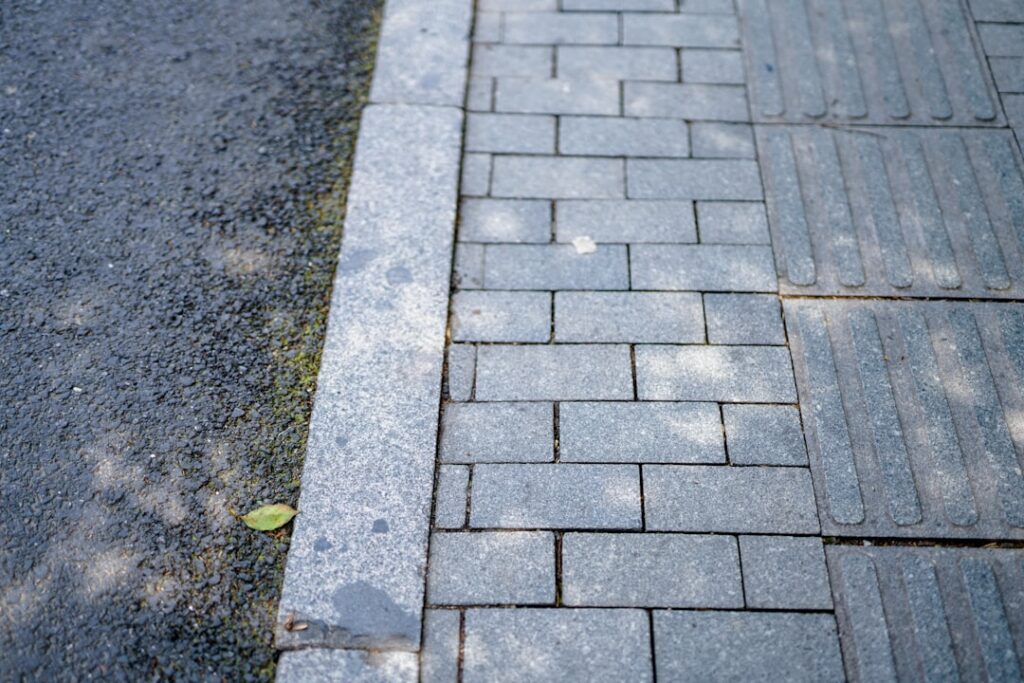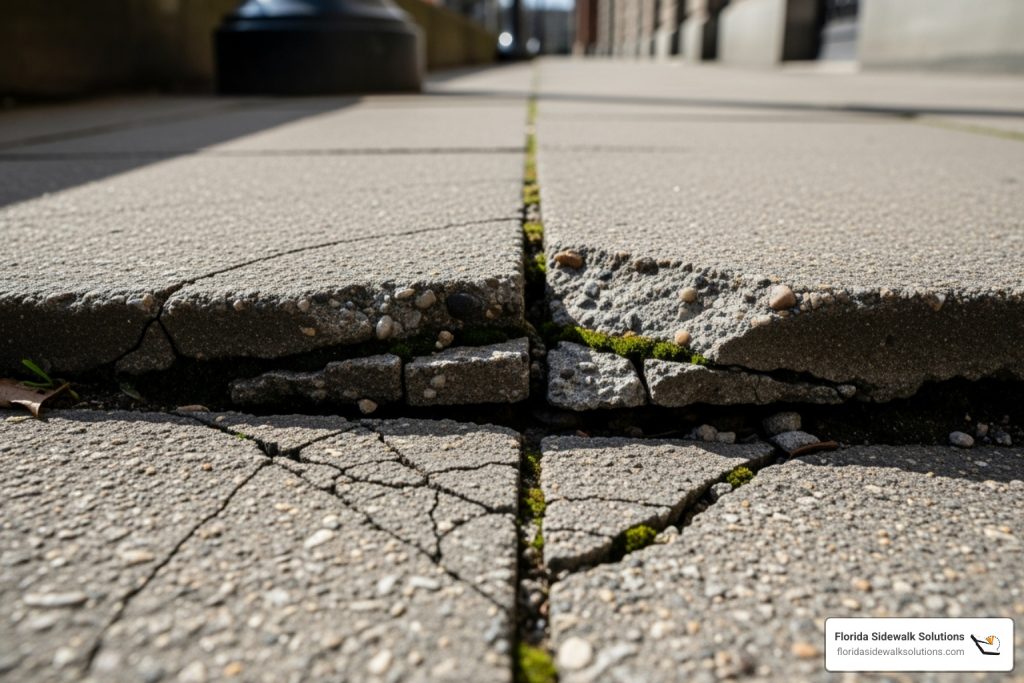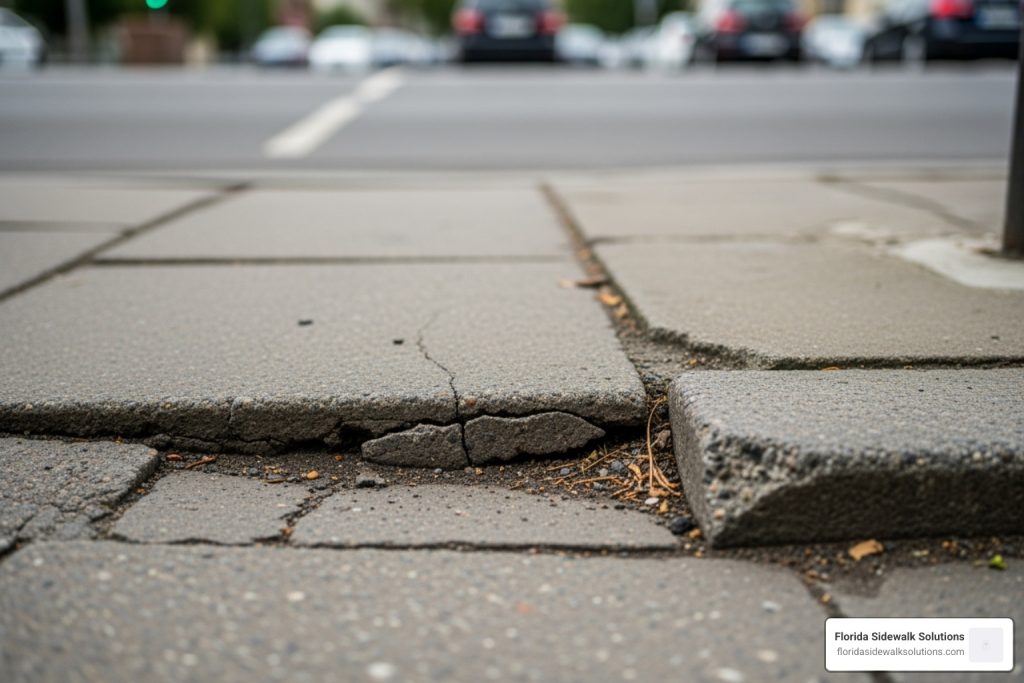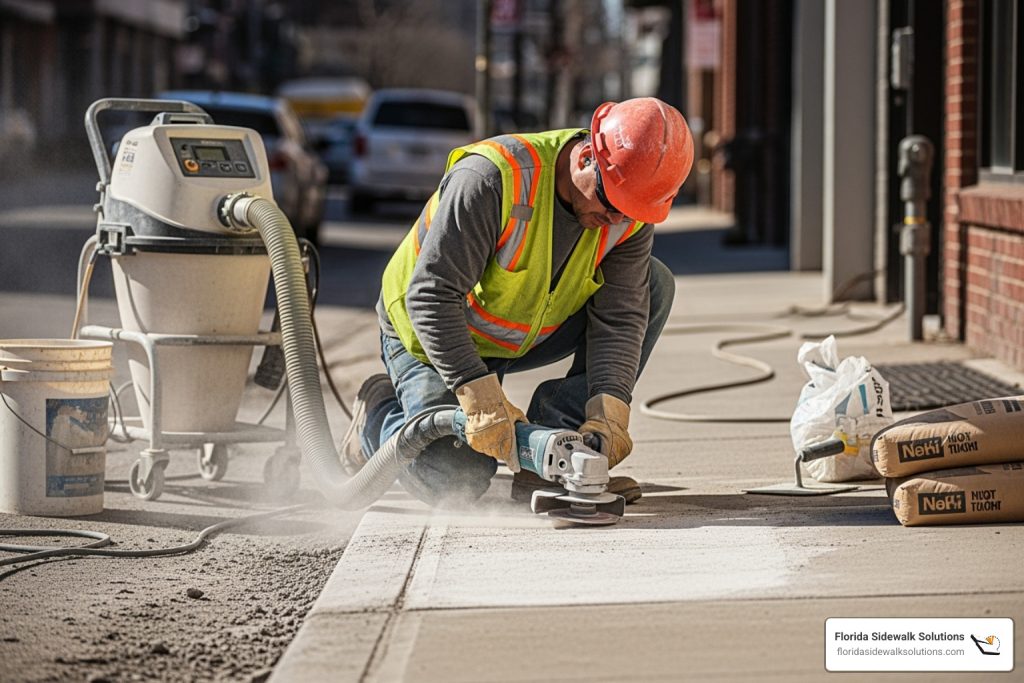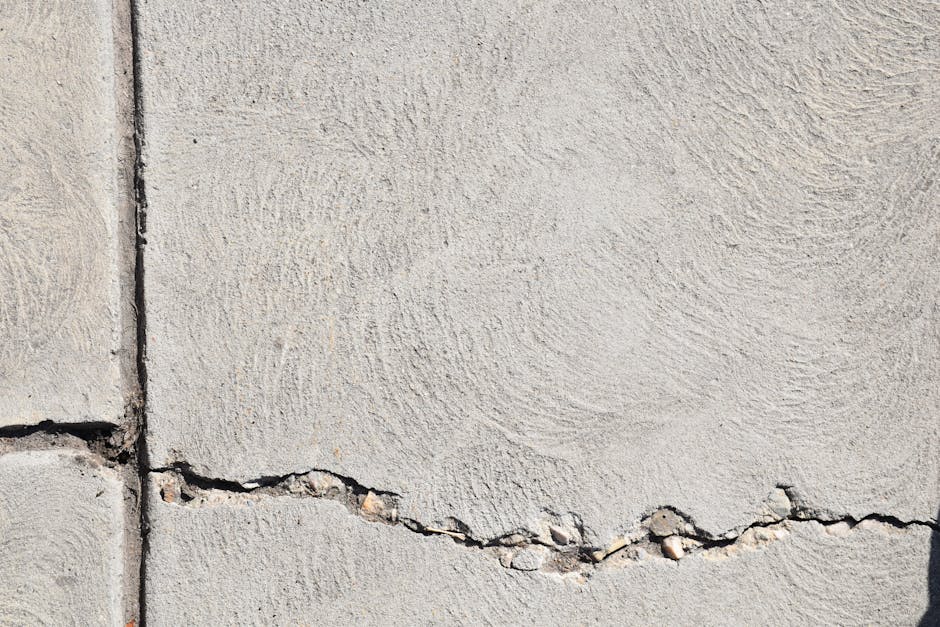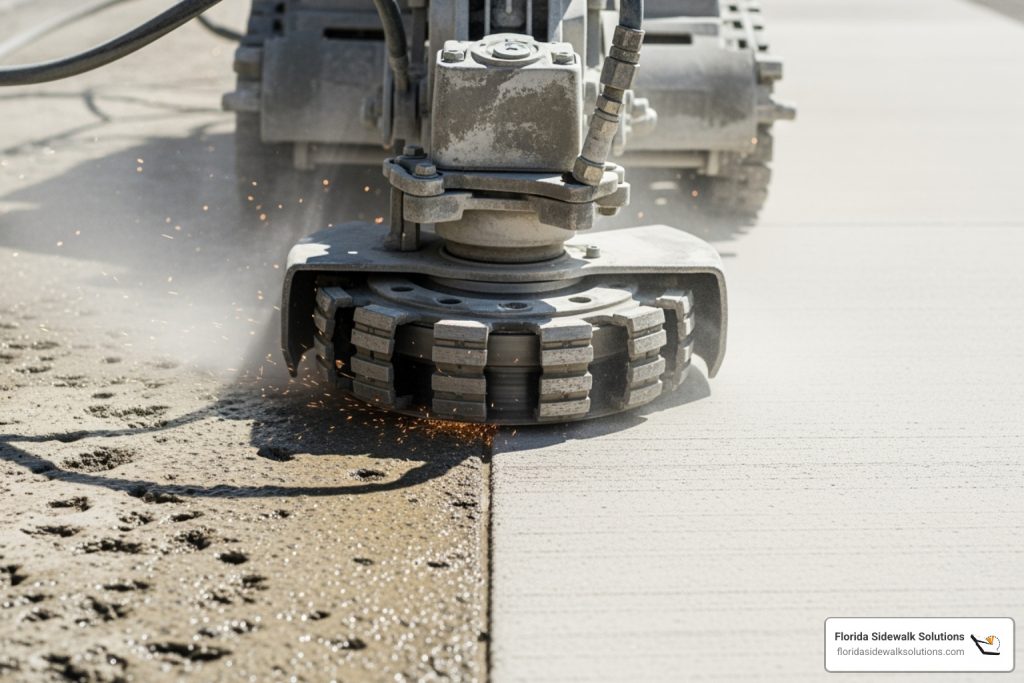Why Affordable Concrete Leveling Matters for Your Sidewalks
Affordable concrete leveling is a cost-effective solution that can save you 50-70% compared to full concrete replacement while eliminating dangerous trip hazards and restoring ADA compliance to your sidewalks.
Quick Answer: Your Most Affordable Options for Sidewalk Repair
- Precision Sidewalk Cutting – $3-8 per linear foot (best for raised trip hazards)
- Full Replacement – $6.50-16.50+ per square foot (only when necessary)
If you’re tired of warning visitors about that uneven front step, or you’re facing liability concerns over dangerous sidewalk trip hazards, you’re not alone. Uneven concrete is one of the most common maintenance issues for municipal managers and property owners across Florida.
The good news? You have options that won’t break your budget.
Traditional concrete replacement can cost thousands of dollars and take days to complete. Modern leveling methods—especially precision sidewalk cutting—offer a faster, more affordable alternative. For Municipal Maintenance Managers dealing with budget constraints and ADA compliance requirements, understanding these options is critical to making smart repair decisions.
This guide walks you through the most effective and economical methods for leveling concrete sidewalks. You’ll learn why sidewalks become uneven, which repair method works best for different situations, and exactly what you should expect to pay in 2025.
Whether you’re managing miles of public walkways or just need to fix a few hazardous panels, you’ll find the information you need to choose the right solution.

Why Sidewalks Become Uneven: Understanding the Root Causes
Before you can choose the right affordable concrete leveling solution for your sidewalk, it helps to understand what’s causing those dangerous trip hazards in the first place. Knowing the “why” behind uneven concrete makes it easier to select a repair method that actually lasts.
Here’s the simple truth: the ground beneath your sidewalk is constantly moving. And in Florida, with our heavy rainstorms followed by dry spells, that movement happens more than you might think.
When soil shifts, settles, or washes away, it stops supporting the concrete above it. That’s when you start seeing problems—panels that rock when you step on them, water that pools in odd places, or raised edges that become trip hazards.
How to Spot the Warning Signs
You might notice that uneven sidewalk signs show up gradually. Maybe your front step looks slightly tilted, or a section of walkway doesn’t quite line up anymore. Sometimes you can see water pooling after a rainstorm where it never did before.
The most critical warning sign? Any trip hazard over 1/4 inch in vertical height. That’s the threshold where a simple uneven spot becomes a genuine safety issue—and an ADA compliance concern for commercial properties. If you can catch a shoe edge on it, it’s a problem that needs fixing.
Rocking panels are another dead giveaway. When a concrete slab moves under your weight, there are definitely voids underneath where solid soil should be. And water pooling on your sidewalk isn’t just annoying—it’s actively making the problem worse by seeping into the ground and washing away even more supporting soil.
What’s Actually Causing Your Sidewalk to Settle
Soil settlement is often the main culprit, especially if the ground wasn’t properly compacted before the concrete was poured. Over time, even well-compacted soil can settle naturally, creating gaps beneath your sidewalk panels.
Florida’s weather patterns create another major issue: soil erosion and washouts. When heavy rain hits, water can wash supporting soil right out from under your concrete. This is especially common near downspouts, around leaky irrigation systems, or anywhere drainage isn’t quite right. One good storm can create a void that causes a slab to sink.
Then there’s tree root growth—probably the most dramatic cause of sidewalk problems. As trees mature, their roots expand with surprising force. They don’t just lift sidewalks; they can crack and completely displace heavy concrete panels.
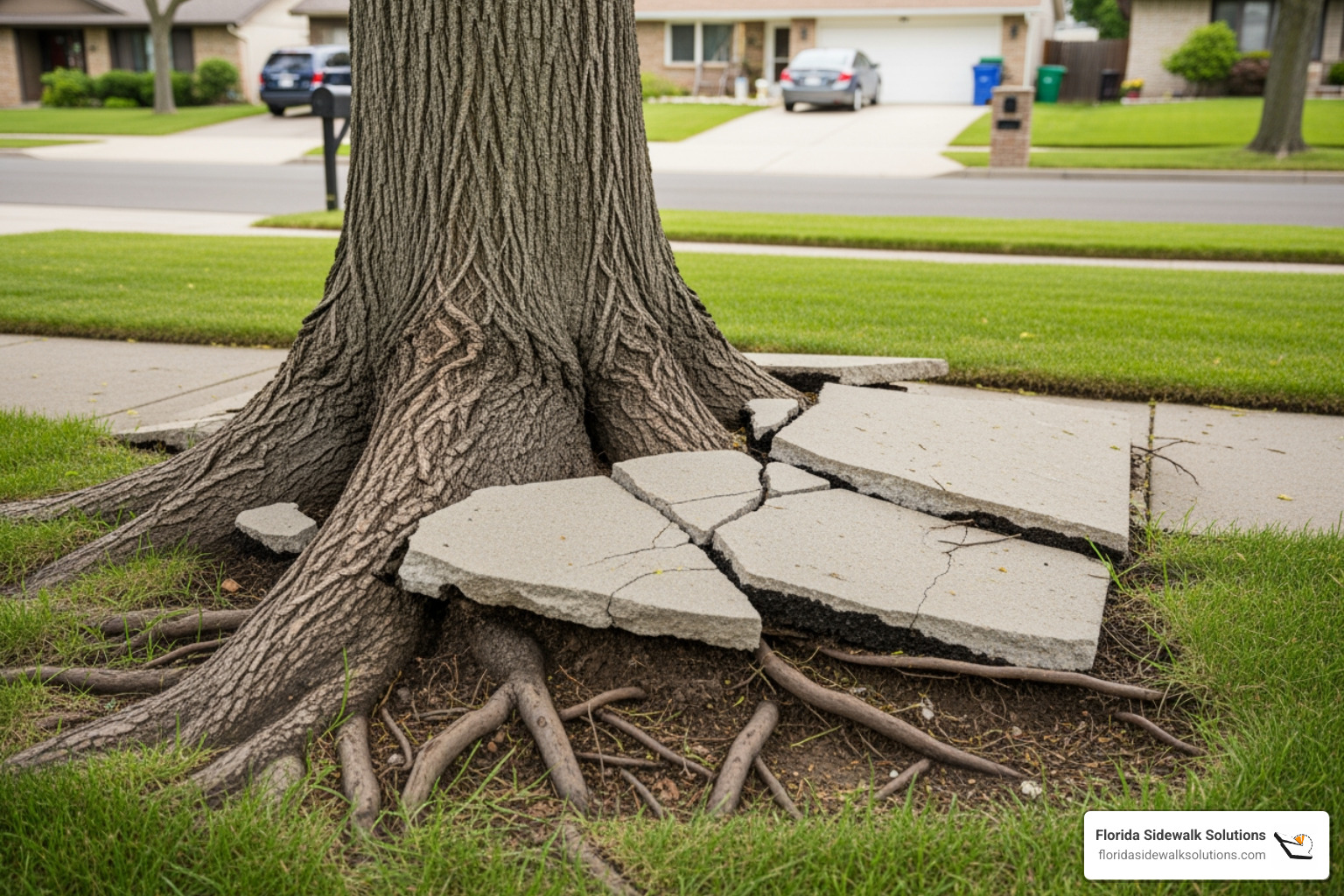
Understanding these root causes matters because it helps you choose a repair method that fixes not just the symptom, but the actual problem. For raised trip hazards caused by root upheaval or shifting panels, precision cutting removes the hazard permanently without adding weight to already-compromised soil. For sunken sections, you’ll need a different approach that addresses the voids underneath.
The good news? Once you know what’s causing your specific sidewalk problem, you can select the most effective and economical solution—which is exactly what we’ll cover in the next section.
A Homeowner’s Guide to Sidewalk Leveling Methods
When you’re staring at an uneven sidewalk panel that’s become a hazard, you need to know your options. Let’s walk through the most effective approaches to fixing those dangerous trip hazards, so you can make the best decision for your property.
The good news? Not all sidewalk problems require the same solution. Understanding which method works best for your specific situation can save you thousands of dollars and weeks of disruption.
Precision Sidewalk Cutting: The Florida Sidewalk Solutions Method
Here’s where we get to talk about what makes our approach different—and frankly, better for sidewalk trip hazards.
At Florida Sidewalk Solutions, we’ve developed a method that’s laser-focused on one thing: eliminating trip hazards quickly, safely, and permanently. While other companies might try to lift sunken slabs or grind down rough surfaces, we use our patented concrete cutting technology to create smooth, safe transitions between uneven sidewalk panels.
Think of it this way: when one panel is raised higher than its neighbor, we don’t mess with the foundation underneath. Instead, we precisely remove just the right amount of material from the raised section to create a gentle, sloped transition. It’s like creating a tiny ramp that eliminates the dangerous lip entirely.
Our cutting technique is far superior to conventional scabblers or concrete grinders. Those tools leave rough, unsightly surfaces that can still catch shoes and walker wheels. Our method creates smooth, sloped transitions that meet ADA-compliant results every single time.
Here’s what makes this approach ideal for sidewalks and walkways: We’re not adding any weight to your soil. This is crucial in Florida, where shifting soils and heavy rainfall already challenge your concrete. Methods that pump heavy materials underneath can actually cause future problems by overloading unstable ground. We avoid that entirely.
The best part? Your sidewalk is immediately usable when we’re done. No waiting days for concrete to cure, no keeping people off the walkway, no disruption to your daily routine. We finish the job, clean up, and you’re back in business.
This is affordable concrete leveling at its finest—a permanent, safe solution that addresses the exact problem without unnecessary demolition or expense. It’s why municipal managers and property owners across Florida trust us for their trip hazard removal needs.
More info about sidewalk repair services
The Last Resort: Full Concrete Replacement
Sometimes—and we’ll be honest with you about this—cutting or leveling just won’t work. When concrete has reached the end of its useful life, replacement becomes necessary.
You’ll know it’s time for replacement when you see severely cracked or crumbling concrete. We’re talking about slabs that have broken into multiple small pieces, concrete that’s literally falling apart, or surfaces with widespread structural failure throughout. If the concrete looks more like a jigsaw puzzle than a solid surface, leveling won’t help.
The replacement process is exactly what you’d expect: demolition with jackhammers, hauling away tons of broken concrete, preparing the base, and pouring an entirely new slab. It’s noisy, messy, and expensive—typically running between $6.50 and $16.50+ per square foot, including removal and installation.
Here’s the reality: replacement takes days to complete, creates significant disruption to your property, and requires you to stay off the new concrete for at least several days while it cures. For a typical sidewalk project, you’re looking at a week or more of inconvenience.
That’s why we always recommend exploring precision cutting first. When you’re dealing with raised trip hazards on otherwise sound concrete, our method can save you 50-70% compared to replacement. Why demolish perfectly good concrete when you can simply eliminate the hazard?
Of course, if your sidewalk truly needs replacement, we’ll tell you straight. Our goal is to provide the right solution for your situation—not the most expensive one.
The True Cost of Repair: Affordable Sidewalk Leveling Comparison
Let’s talk about money. When you’re facing uneven sidewalks or dangerous trip hazards, you want to know what you’re getting into financially. The good news? You have options that won’t drain your budget.
At Florida Sidewalk Solutions, we believe in complete transparency about costs. Our precision cutting method delivers real value for targeted trip hazard removal, and we think you’ll appreciate the savings when you compare it to traditional concrete replacement.
Here’s how the numbers stack up:
| Factor | Precision Sidewalk Cutting (Florida Sidewalk Solutions) | Full Concrete Replacement |
|---|---|---|
| Average Cost | $3-8 per linear foot (per trip hazard) | $6.50–$16.50+ per square foot (including removal and new slab) |
| Speed/Downtime | Immediate usability | 3-7 days (demolition, pouring, curing) |
| Best For | Eliminating trip hazards, ADA compliance, raised panels | Severely cracked, crumbling, or structurally failed slabs |
| Longevity | Permanent fix for the specific trip hazard | Long-term, but subject to new soil settlement over time |
Affordable Sidewalk Leveling: Cost per Hazard or Square Foot
When it comes to affordable concrete leveling, our precision cutting approach stands out for one simple reason: you only pay for what you need fixed.
Our precision cutting cost is typically priced per linear foot of the trip hazard itself. Think about it—you’re not paying to replace an entire sidewalk panel when only one edge is raised. You’re paying to eliminate the specific hazard that’s creating a safety issue. This targeted approach makes it an incredibly cost-effective solution for Florida property owners.
Full replacement costs, on the other hand, range from $6.50 to $16.50+ per square foot. That price includes demolishing the old concrete, hauling it away, and pouring a completely new slab. For even a modest sidewalk, those costs add up fast.
Here’s the statistic that matters most: Affordable concrete leveling methods like precision cutting consistently save property owners 50-70% compared to full replacement. That’s real money back in your budget—money you can use for other property improvements or simply keep in your pocket.
Factors That Influence Your Project’s Price
While our precision cutting method is inherently budget-friendly for trip hazards, every project is unique. Several factors can influence what you’ll ultimately pay:
The number of trip hazards you need addressed is the biggest factor. A single raised panel at your front entrance will cost significantly less than a long stretch of sidewalk with multiple hazards along the way. This is straightforward—more hazards mean more work.
The severity of the elevation change also matters. A minor 1/4 inch lip requires less material removal than a dramatic 2-inch difference. Our patented technology handles both efficiently, but the depth and angle of the cut naturally affect the complexity of the work.
The length of sidewalk requiring attention directly impacts your cost. Whether you’re dealing with a short residential walkway or a lengthy commercial sidewalk, we measure and price based on the linear footage that needs our attention.
Accessibility for equipment can occasionally influence pricing. If we’re working in a tight space or an area that’s challenging to reach with our specialized equipment, it might require a bit more setup time. The good news? Our equipment is designed to be compact and versatile, so we can work efficiently in most residential and commercial settings across Florida without significant access issues.

The bottom line? Every sidewalk situation is different, which is why we offer free on-site evaluations. We’ll assess your specific trip hazards, measure what needs to be done, and give you an accurate estimate with no surprises. It’s the best way to understand exactly what your concrete sidewalk repair will cost—and how much you’ll save compared to replacement.
Sidewalks and Walkways: Prioritizing Safety and ADA Compliance
If you’re a property owner or municipal manager in Florida, you already know that maintaining safe sidewalks isn’t optional—it’s essential. Uneven sidewalks create dangerous trip hazards that can lead to serious injuries, and with those injuries come potential lawsuits and liability headaches. This is where affordable concrete leveling becomes more than just a cost-saving measure; it’s your protection against risk.
Trip hazard liability is real, and it’s serious. As a homeowner, you’re responsible for keeping your property safe for visitors, mail carriers, and anyone else who steps onto your walkway. For commercial property owners and municipal managers, the stakes are even higher. A single trip-and-fall incident can result in costly legal action, not to mention the harm to someone who gets injured. Taking proactive steps to eliminate these hazards isn’t just smart—it’s necessary.
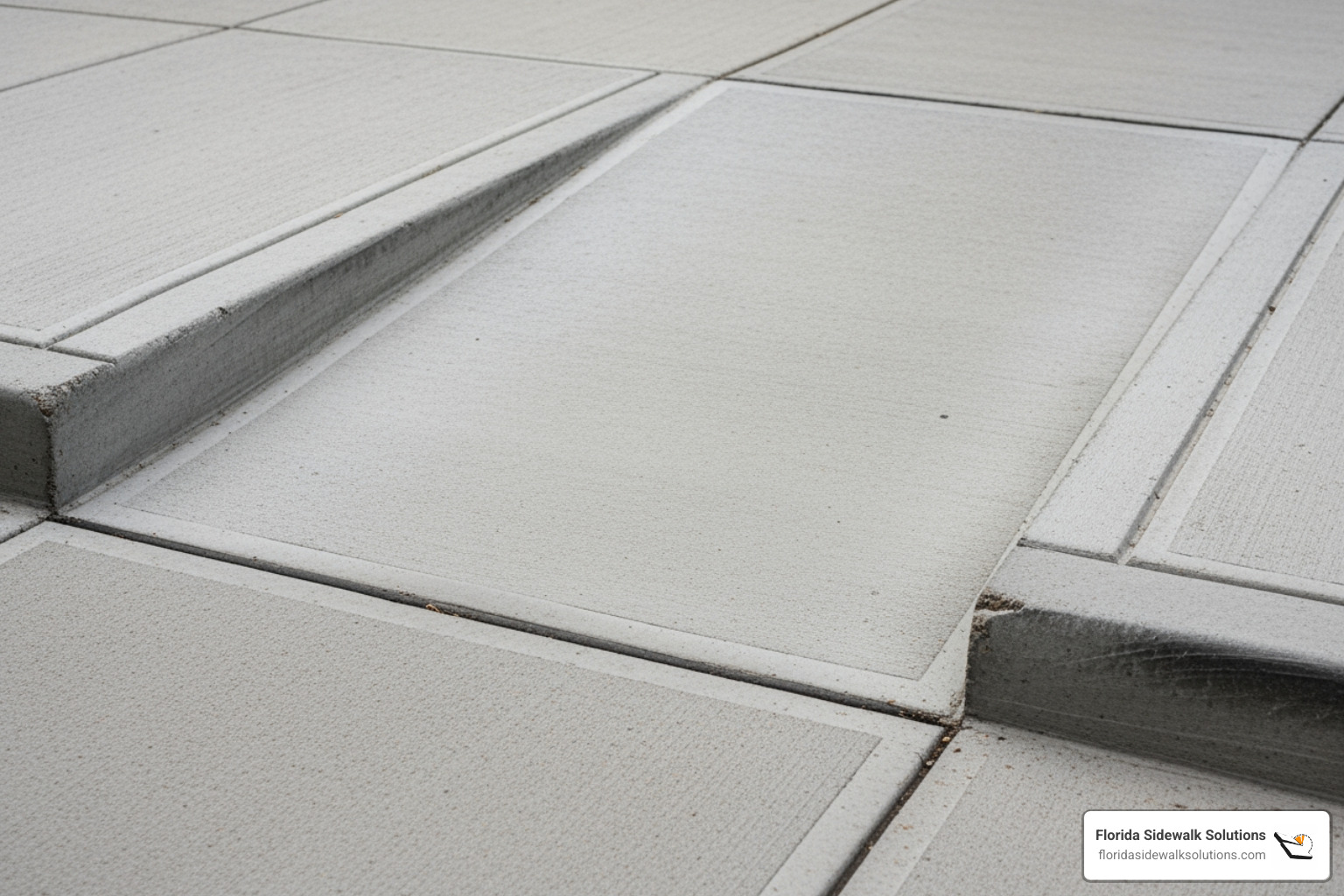
For commercial properties and public spaces across Florida, there’s another critical consideration: ADA compliance. The Americans with Disabilities Act (ADA) sets clear standards for accessibility, and your sidewalks must meet them. This isn’t about checking a box—it’s about ensuring everyone, regardless of mobility, can safely steer your walkways.
So what exactly does ADA compliance mean for your sidewalks? The regulations are specific, and understanding them helps you see why precision matters. The most important rule to remember is the 1/4 inch vertical change threshold. Any elevation change greater than 1/4 inch is officially considered a trip hazard and must be addressed. If you have a vertical change between 1/4 inch and 1/2 inch, it needs to be beveled with a slope no steeper than 1:2. Anything over 1/2 inch requires a ramp or another compliant transition solution.
This is where our precision cutting method truly shines. We don’t just smooth out rough spots—we create ADA-compliant results that meet these exact specifications. Our patented technology allows us to cut precise, gentle slopes that eliminate trip hazards completely while ensuring full compliance with accessibility standards.
Why does our precision cutting method work so well for sidewalks and walkways? First, it ensures compliance every time. We’re not guessing or estimating—our equipment creates the exact slope needed to meet ADA requirements. Second, our method adds no added weight to soil, which is a significant advantage in Florida’s shifting soils. Other leveling methods that pump material under the slab can actually cause new settlement problems down the road by adding extra weight. We avoid that issue entirely.
Perhaps most importantly, we create a permanent, safe slope that lasts. By physically removing the raised concrete rather than trying to lift sunken sections, we provide a lasting solution to your specific trip hazard. You won’t need to revisit the same problem in a few years—it’s fixed for good.
For municipal managers working with tight budgets and strict compliance requirements, and for property owners who want to protect their investment and their visitors, precision sidewalk cutting offers the ideal combination of safety, compliance, and affordability. It’s a solution you can feel confident about, knowing you’ve addressed the problem correctly the first time.
Concrete Leveling Costs: The Ultimate Guide [2025 Prices]
Frequently Asked Questions About Sidewalk Leveling
We understand you likely have questions about the process, longevity, and practicality of sidewalk leveling. Here, we address some of the most common inquiries we receive from property owners and managers across Florida.
How long does sidewalk leveling last?
The longevity of any concrete repair depends on several factors, and it’s important to understand what “lasting” really means in the context of sidewalk trip hazards.
For our precision sidewalk cutting method, the results are a permanent fix for the specific trip hazard we address. Once we’ve precisely cut and sloped the concrete to eliminate that vertical displacement, that particular hazard is gone for good. The concrete isn’t going to magically grow back or shift in that exact spot.
Now, does that mean your entire sidewalk will never have another issue? Not necessarily. New problems could develop from different factors—perhaps new tree root growth in another area, or soil erosion that creates a void somewhere else down the line. But the specific point we’ve repaired stays repaired.
This is different from other leveling methods that lift sunken slabs. Those solutions depend heavily on soil conditions and water management. If you’ve got good drainage and stable soil, some slab lifting methods can last for many years when installed correctly. But if the underlying cause (like poor drainage or aggressive tree roots) isn’t addressed, you might see new settlement over time.
The quality of work matters tremendously, too. That’s why working with experienced professionals who understand Florida’s unique soil conditions makes all the difference in getting a repair that truly lasts.
How soon can I use the sidewalk after it’s leveled?
This is one of the biggest advantages of our precision sidewalk cutting method, and it’s something our clients consistently appreciate!
With our technique, the sidewalk is immediately usable after we complete the work. No waiting around, no “keep off” signs, no cones blocking the path. We finish the cut, clean up, and you’re good to go. Walk on it, roll your wheelchair over it, push your stroller across it—whatever you need to do.
This immediate usability means minimal disruption to pedestrian traffic, which is especially beneficial for busy commercial properties or public walkways throughout Florida. If you’re managing a shopping center in Fort Myers or maintaining municipal sidewalks in Boca Raton, you can’t afford to have walkways closed for days on end.
Compare that to other methods: slab lifting techniques can require anywhere from 30 minutes to 48 hours for the material to cure before the surface is ready for traffic. Our method offers the fastest return to normalcy, period.
Is DIY sidewalk leveling a good idea?
We get it—saving money by tackling projects yourself is appealing. But DIY sidewalk leveling is generally not a good idea and can often lead to more problems (and more expense) than it solves.
Here’s the reality: our precision cutting requires specialized, patented equipment that simply isn’t available to homeowners. You can’t rent it at your local hardware store, and there’s no YouTube tutorial that’s going to walk you through operating machinery you don’t have access to.
Beyond equipment, there’s the matter of specialized knowledge. Accurately assessing why a sidewalk settled, understanding how Florida’s soils behave, and executing precise cuts that meet ADA compliance standards requires significant training and experience. We’ve spent years perfecting our technique and understanding the nuances of concrete repair.
The risks of DIY attempts are real and costly. You could crack the slab further, create new trip hazards worse than the original, or damage underground utilities you didn’t know were there. You might waste money on materials that don’t work or tools you’ll never use again. And perhaps most importantly, a DIY fix is extremely unlikely to meet ADA compliance standards, leaving you exposed to liability if someone gets injured.
There’s also the safety factor—working with concrete and power tools carries inherent dangers, especially when dealing with unstable slabs.
Our recommendation? Concrete leveling, especially for sidewalks where safety and ADA compliance are critical, is best left to experienced professionals. We have the tools, training, and expertise to ensure the job is done safely, effectively, and to the highest standards. The peace of mind alone is worth the investment in professional affordable concrete leveling services.
When you’re ready to address your sidewalk trip hazards, find a reputable contractor who specializes in the specific service you need. We’re here to help make your sidewalks safe, compliant, and worry-free.
Conclusion: Make the Smart, Affordable Choice for Your Sidewalks
Throughout this guide, we’ve walked through why sidewalks become uneven—from Florida’s shifting soils to tree roots pushing up from below—and we’ve explored the various methods available to fix these problems. If there’s one thing to remember, it’s this: while full concrete replacement has its place, affordable concrete leveling is almost always the smarter choice for sidewalk trip hazards.
The right method depends on what you’re dealing with. If your concrete is severely cracked, crumbling into pieces, or structurally failing throughout, then yes, replacement might be your only option. But for the vast majority of sidewalk problems—those raised panels creating dangerous trip hazards in Fort Lauderdale, Coral Springs, and communities across Florida—our precision cutting method solves the problem faster, cheaper, and more permanently.
Think about what you gain by choosing precision sidewalk leveling. You’re saving 50–70% compared to replacement costs, which means more money stays in your budget for other property improvements. You’re eliminating trip hazards that could cause serious injuries and costly liability claims. You’re improving your property’s appearance with smooth, even walkways that make a great first impression. And you’re ensuring ADA compliance, which protects you legally while making your property accessible to everyone.
Perhaps best of all? Your sidewalks are ready to use the moment we finish. No waiting days for concrete to cure. No cordoning off areas or rerouting foot traffic. Just immediate, safe, beautiful results.
At Florida Sidewalk Solutions, we’ve built our reputation on solving one problem exceptionally well: sidewalk trip hazards. Our patented cutting technology gives us an edge that conventional methods simply can’t match. We’re not trying to do everything—we’re focused on doing this one thing better than anyone else.
Your uneven sidewalks don’t have to be a constant worry or a budget-breaking repair. There’s a better way, and we’d love to show you exactly what it looks like for your property.
Contact us for a free estimate on your concrete sidewalk repair


